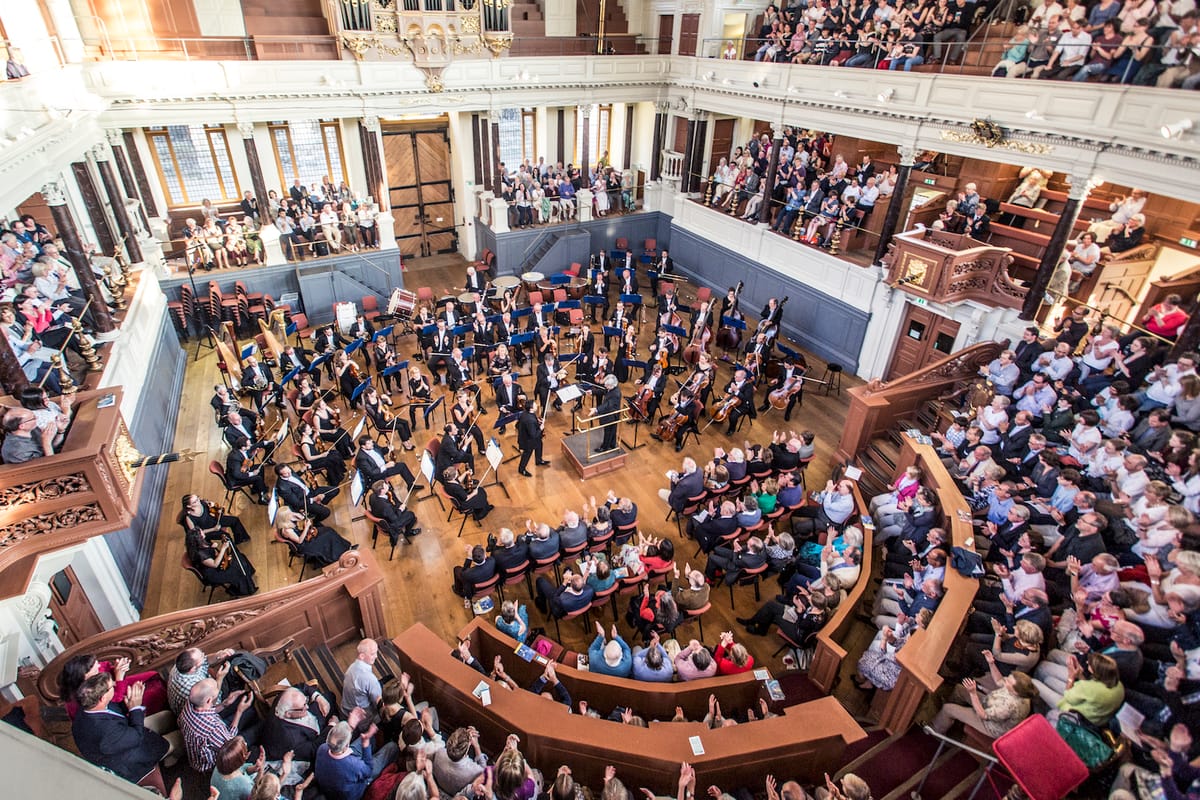A concert at the Sheldonian

A concert at the Sheldonian Theatre in Oxford is, at least for this reviewer, never just a concert at the Sheldonian. Woven into the Sheldonian’s tapestries are the stuff of legend; blending with its paintings are picture windows framing the gleaming, sunburnt walls of Oxford’s architectural treasures. This is a perfect setting for the Oxford Philharmonic Orchestra, whose members are organically related to the city, their charming unworldliness reflected in real enjoyment on individual members’ faces that would be hard to find in more commercial enterprises.
Brahms’ D major Violin Concerto opened the concert; challenging in itself, but even more so on a hot day when concentrated sunlight bore directly down on the soloist as well as some members of the orchestra, it was competently performed. Brahms dedicated this to his friend, the violinist Joseph Joachim, who said of it: “The Germans have four violin concertos. The greatest, most uncompromising is Beethoven’s. The one by Brahms vies with it in seriousness. The richest, the most seductive, was written by Max Bruch. But the most inward, the heart’s jewel, is Mendelssohn’s.” While one might disagree with Joachim’s ratings – many might think of Brahms’ Violin Concerto as being the most “seductive” – it is clearly one of the most important in the repertoire.
The opening movement Allegro non troppo is in the key of D major, with a gentle beginning that leads to a first theme replete with passionate entreaty, as it is passed between orchestra and violin. The conductor Marios Papadopoulos took this a shade too slowly, which had the effect of dragging out and compromising the fluent beauty of the two principal themes, and making their development somewhat studied. The concluding cadenza was, however, creditably executed by the soloist, Maxim Vengerov. The second movement, a very calming Adagio, has an exquisite, fleeting beauty so characteristic of many of Brahms’ slow movements. The final movement Allegro giocoso, ma non troppo vivace – Poco più presto in the home key of D major was played with brio by soloist and orchestra. This emphasis on major keys throughout is unusual for Brahms: no pondering tragedy weighs this concerto down.
Tchaikovsky’s Fourth Symphony is a complete contrast to this, with its sense of an inevitable doom. In his programmatic outline, the composer wrote: “All life is an unbroken alternation of hard reality with swiftly passing dreams and visions of happiness … No haven exists … Drift upon that sea until it engulfs and submerges you in its depths”. This symphony was written in the shadow of a disastrous marriage – Tchaikovsky had married only to disguise his homosexuality and his bride then turned out to have psychological problems. The composer’s emotional breakdown, which included a suicide attempt, seemed to make him sacrifice form to content even more than usual; this led to a very critical reception, where the symphony was seen to be formless and overly long. This criticism is especially true of the first movement, Andante sostenuto – Moderato con anima – Moderato assai, quasi Andante – Allegro vivo, which is dominated by the ‘Fate’ fanfare played by the brass. Menacing and shrill, the theme of fate insistently overpowers any gentler episodes, and is, in the composer’s words, ‘”the fatal power which prevents one from attaining the goal of happiness … There is nothing to be done but to submit to it and lament in vain”. Unusually for a Tchaikovsky symphony, the slow movement Andantino in modo di canzona has no sublime melodies to offer, only a sustained greyness that gives way to the grief of the first movement. In fact it is the last two movements, Scherzo: Pizzicato ostinato — Allegro and Finale: Allegro con fuoco, which are the most impressive in compositional terms; shrugging off the forces of destiny, they valiantly confirm human hope against expectation. The Scherzo is among the most original movements of its kind, with a pizzicato ostinato on the strings that conjures up the glimmer of fireflies penetrating the thickest darkness, each evanescent burst followed by a fresh flare; a footloose and fancy-free interlude led by the oboe with staccato brass and woodwinds follows, until the return of the sparkling pizzicato, which ends the movement as quietly as it began. The mood of the Finale is vigorous and rustic; based on a Russian folk melody “In the field stood a birch tree”, it embodies Tchaikovsky’s comments: “If you have no pleasure in yourself, look about you. Go to the people. See how they can enjoy life and give themselves up entirely to festivity.” The ‘Fate’ fanfare returns briefly, but is unable to drown the surrounding gaiety, as the movement, and the symphony, end on a triumphant note: “Rejoice in the happiness of others and you can still live.”
Marios Papadopoulos and the Oxford Philharmonic gave a creditable account of this very demanding symphony, for which they were rewarded with repeated curtain calls from an enthusiastic audience, with individual members such as the timpanist getting a special hand for the sheer joy that they conveyed.






